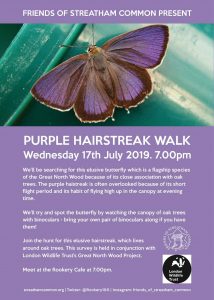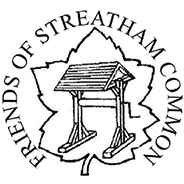 Meet by the Rookery Cafe at 7.00pm to join the hunt for this elusive butterfly, which lives around oak trees.
Meet by the Rookery Cafe at 7.00pm to join the hunt for this elusive butterfly, which lives around oak trees.
This survey is held in conjunction with London Wildlife Trust’s Great North Wood Project.
Scientific name: Favonius quercus
Underwings grey with white streak and small tails, upper wings brown. Males have a purple sheen, females have a purple mark on forewing.
This handsome butterfly is widely distributed throughout southern areas wherever there are oak trees; even a solitary tree may support a colony. It is frequently overlooked as adults remain largely in the canopy where the main adult food source is honeydew; they fly more commonly in the evening of a warm summer’s day. They are only driven down to seek fluid and nectar during prolonged drought, as occurred in 1995-6.
There has been a recent increase in records and an extension of the range of this butterfly especially in the English Midlands and south-west Scotland, even in urban areas (including London) which may be related to improvements in atmospheric quality. White-letter Hairstreak is similar but has W-shaped streak.
Size and Family
Family: Hairstreaks
Size: Small
Wing Span Range (male to female): 37-39mm
Conservation Status
Butterfly Conservation priority: Low
Fully Protected under the 1985 Northern Ireland Wildlife Order
European status: Not threatened
Caterpillar Foodplants
The Purple Hairstreak is restricted to Oak trees including both the native species, Sessile Oak (Quercus petraea) and Pedunculate Oak (Q. robur), and the introduced Turkey Oak (Q. cerris). Evergreen Oak (Q.ilex) also may be used.
Lifecycle
Habitat : Difficult to spot as it flies around the tops of Oak trees in woods, hedgerows and parks, including in urban areas.
Distribution
Countries: England, Wales, Ireland and Scotland
Widespread in England and Wales, less common in Scotland and Ireland
Distribution Trend Since 1970’s in Britain: -15%
Information from https://butterfly-conservation.org/50-839/purple-hairstreak.html

